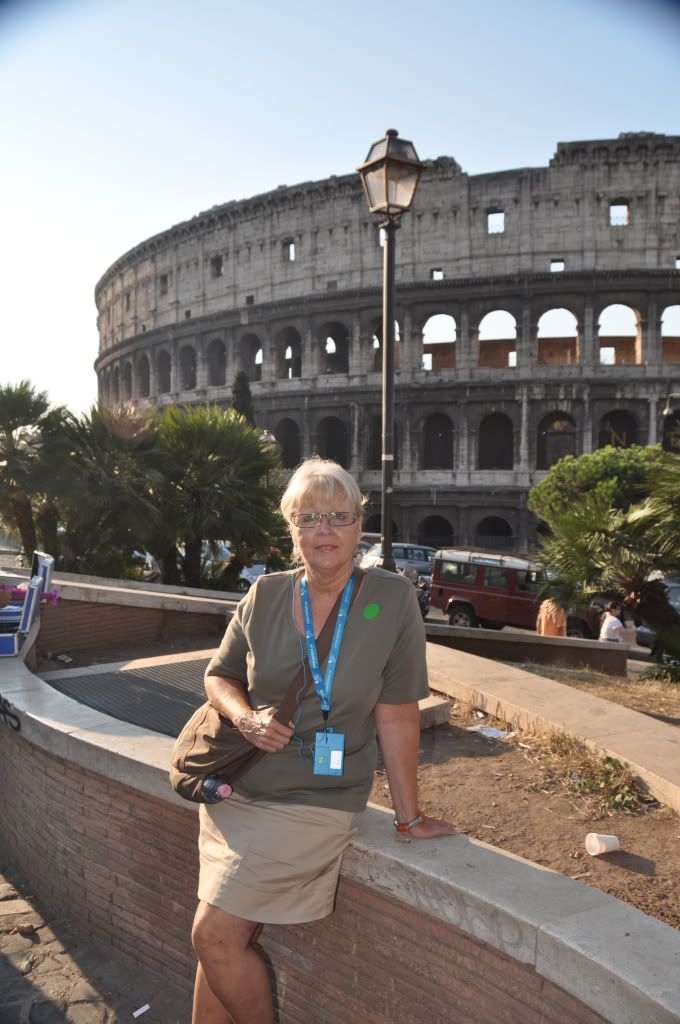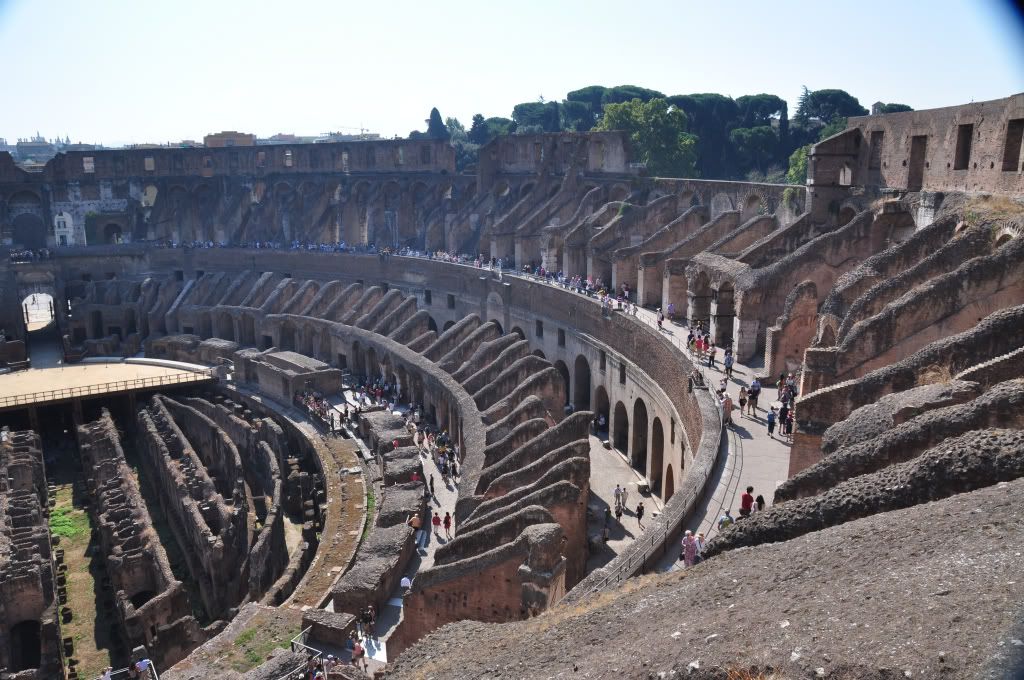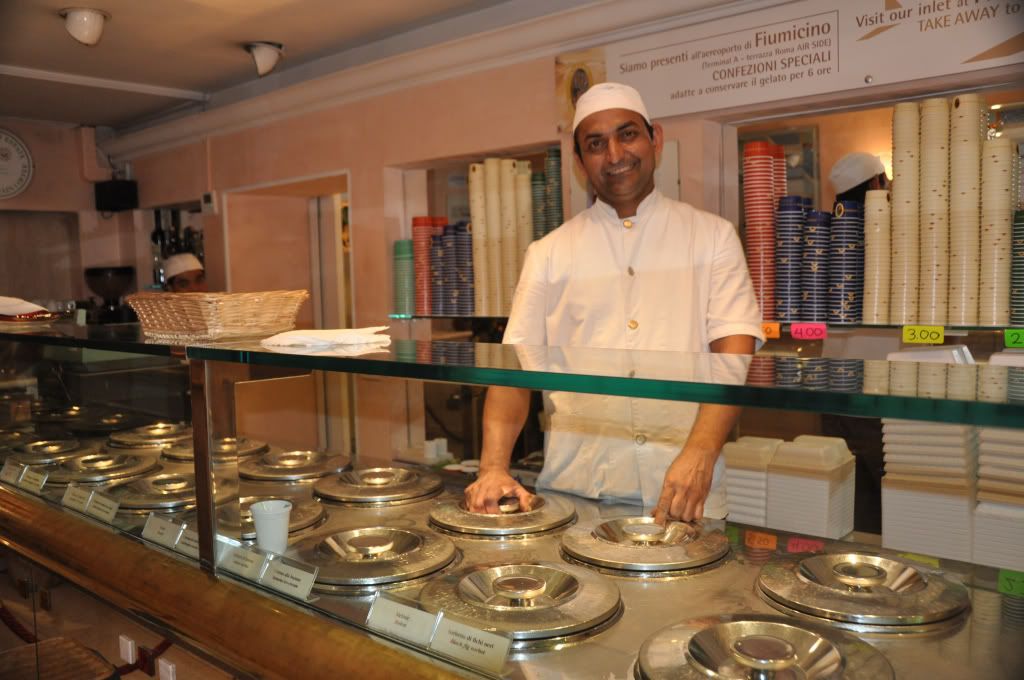Today... the Colosseum.
We decide to avoid the lines (which I have to say, when we arrive at 7:30 AM really don't exist), and purchase a tour. It includes two areas not open to the general public: the lower floors where the animals and gladiators would come into the arena from, and the upper levels, giving us kind of a birds eye view of the whole thing.
As we were walking from the meeting place into the great structure, the guide was giving us a history of the building. There is a statue somewhere else in Rome -- I think of Marcus Aurelius -- that has gold leaf on it. There is a prophecy that when the gold all wears off, Rome will be no more. So the statue was moved to a museum. The prophecy takes on a grander scale here. We are told that is the Colosseum falls, the world will end. A Florentine, the owner of Tods shoes, is donating 25 million euros to restore the structure.
I'm skeptical. First, if you can artificially preserve the life of something, what use is a prophecy? And second... I think the Italians might be a look full of their own self importance.
That said, walking through all of Rome is like an open air museum, and the history lesson isn't lost on me. I love history, especially when it involves war or large scale debauchery of any kind. For example, we learn that in 64 AD, Emperor Nero burned large parts of Rome and blamed it on the Christians. His motive? He wanted to build himself a large home (that self importance thing doesn't sound so judgmental now, does it?) When he dies, the senate realizes they really need to get someone in power who will restore the image of the emperor to the people. Enter Flavius, who reallocates Nero's playground (filled with water and used to stage naval battles) into the Flavian Ampitheatre, or the Colosseum. The name is interesting, and actually inspired by a colossal statue of Nero that once stood out front. Colossal... Colosseum.
Unfortunately, the Colosseum is made of travertine marble, which is a porous stone, making it difficult to clean and maintain. There is an area in from of the structure where you can see the black color from years of traffic and pollution, and the cleaned version from the 1980's, when a bank donated some money that lasted long enough to clean about a three columns-width section. There are 80 on the first floor alone.
The history of events at the Colosseum had me literally transfixed. Unlike today, ancient Rome was extremely organized, and between each column is a roman numeral. Tickets, made of wood or marble bore a Roman numeral corresponding to where spectators were supposed to enter. The steps were made very steep, to slow traffic going in, and speed it going out. The guide said something about it being called vomitonous -- I'm not sure -- but it refers to the steps "vomitting" people out. Gross, but I think the climb does make mom want to vomit a little.
The seating here was organized socially, with the most important people sitting closest to the stage. That included senators, and, of course, the emperor. Events lasted all day. The first part would include fighting between slaves, prisoners... and animals many had never seen before. Imagine sitting in the stands, people are yelling all around you as many have bet on the fights, there are men being brought out one after the other as wild beasts pop up from the floor of the arena stage, brought up using winches to raise the cages. Elephants, lions.... animals not fed for a week prior to the game. So then you've got half eaten corpses cooking in the sun, blood everywhere, and a crowd who just wants more. In the first three months of the amphitheater opening, there were games every day. About ten thousand people died.
After an afternoon siesta, it was time for the gladiators. Some were debtors working off their debts. Others, prisoners who chose this lifestyle. All were very expensive and had to be "rented" for the events, so they made a decent living, despite what could be a short life span. They were oiled to show off their muscles, and women spectators were relegated to the higher floors, lest they fall in love with these specimens of masculinity. The gladiators were not given weapons until they were sent in to the arena. Many became friends, and then would be forced to face each other in battle -- some killed themselves in the dressing room rather than slay a friend. But in the arena, none were allowed to actually decide to make the kill. That was for the emperor. Once it got to that point, the victorious gladiator would stop and look to the emperor for a sign of what to do. The crowd would be going wild, chanting what they wanted the outcome to be -- freedom... or death. The emperor would give. Thumbs up for freedom. A thumb to the side wasn't a good sign for the guy on the ground.
And funny, because it reminds me of how they always show a kill shot in the hood... hand turned to the side.
We also discover that Italians were the original recyclers. On the second and third tiers of the Colosseum, there were statues to the senators. As they were elected yearly, the heads would be removed and replaced with the new official. Very pragmatic. When Rome was in crisis, people needed metal for cannon balls, so they took it from the walls of the structure, which is why there are so many holes in the facade. After Rome fell, the popes sacked the Colosseum, taking the travertine marble from the seats and floors and using it to build St. Peter's Square. They then consecrated the Colosseum as a holy place. Charming.
We also tour the inside of the Roman Forum and Palatine Hill, then hop on the tour bus from yesterday again to properly melt ourselves in the sun. We are cooked when we arrive near Trevi Fountain and I spot a designer outlet store and pop in for a peek. Until I come to the realization that mom is just done. I pay for my completely unnecessary elbow length leather gloves and head out to get us some lunch. Afterwards, it's back tot e apartment for a four hour snooze. It think we both needed it.
We are just heading out to dinner now to a place mom has been dying to go -- the Tritone Antica Trattoria. She has a great memory of this place from her last visit here. But first... a glass of wine at the News Cafe to post this blog entry. And after? Gelato.
When in Rome...



No comments:
Post a Comment